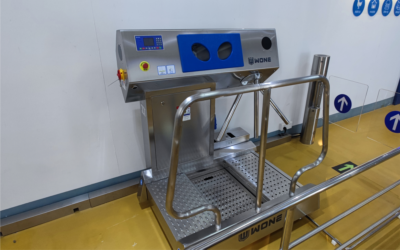Why is hygiene station Located at the Entrance of the food plant?
 Maintaining the highest level of hygiene is crucial for any industry involved in the production, handling, and distribution of food. As contamination can have serious consequences for consumer health, it is essential to enforce strict hygiene practices throughout the entire food supply chain. One effective measure adopted by the food industry is the installation of hygiene stations at their entrances. These stations serve multiple purposes, ensuring the safety and quality of the food products and protecting the reputation of the industry.
Maintaining the highest level of hygiene is crucial for any industry involved in the production, handling, and distribution of food. As contamination can have serious consequences for consumer health, it is essential to enforce strict hygiene practices throughout the entire food supply chain. One effective measure adopted by the food industry is the installation of hygiene stations at their entrances. These stations serve multiple purposes, ensuring the safety and quality of the food products and protecting the reputation of the industry.
The primary objective of a hygiene station is to prevent the entry of bacteria, viruses, allergens, and other harmful agents into the food processing or handling areas. By placing these stations at the entrance, the food industry aims to minimize the risk of contamination from external sources. Employees, suppliers, and visitors are required to go through a thorough set of hygiene procedures before entering the production or storage areas. This includes washing hands, donning protective clothing, and disinfecting footwear.
One of the key reasons for locating hygiene stations at the entrance is to promote and reinforce a culture of hygiene within the food industry. By making these stations the first point of contact, employees and visitors are reminded of the importance of maintaining cleanliness and following proper hygiene practices. This constant reminder helps to instill a sense of responsibility and creates a mindset where hygiene is valued as an integral part of the food production process.
Another important factor to consider is the regulation and compliance requirements set by food safety authorities. Hygiene stations at the entrance serve as a visible demonstration of the industry's commitment to adhering to these regulations. By showing a proactive approach towards hygiene, businesses can not only avoid penalties but also gain a competitive advantage by building trust and credibility among consumers.
In addition to preventing contamination and complying with regulations, hygiene stations at the entrance also contribute to operational efficiency. By providing a dedicated space for hygiene procedures, these stations help streamline the process and prevent unnecessary delays in the workflow. This ensures that employees and visitors can quickly comply with the required hygiene practices, allowing operations to continue smoothly and without interruptions. Moreover, by reducing the risk of contamination, businesses can minimize the chances of product recalls, leading to cost savings and preserving the company's reputation.
Effective communication is another reason for placing hygiene stations at the entrance. By making these stations easily accessible and visible, businesses can effectively communicate their commitment to hygiene to all stakeholders. This includes employees, suppliers, customers, and regulatory authorities. Being able to see the hygiene station at the entrance creates a sense of transparency and reinforces the message that hygiene is a top priority for the food industry.
In conclusion, the placement of hygiene stations at the entrance of the food industry is a strategic decision aimed at minimizing the risk of contamination, promoting a hygiene culture, ensuring compliance with regulations, improving operational efficiency, and communicating the industry's commitment to hygiene. By investing in these stations, businesses not only protect the health and safety of consumers but also safeguard their own reputation and commercial success. It is a proactive approach that benefits both the industry and the consumers it serves.


